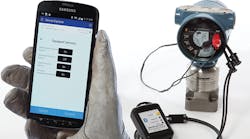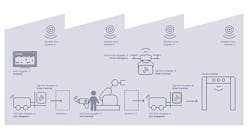From “see what I see” collaborative platforms to augmented reality assistants, field workers across industry are coming to rely on commercial smartphone platforms like never before. Whether installed on personal, bring-your-own devices (BYODs) or ruggedized, intrinsically safe, company-issued handsets, applications based on the iOS and Android platforms are easy to download, easy to manage and readily integrate with other apps in the Apple and Google ecosystems.
We expect this in our personal lives, and that same flexibility, functionality and convenience is increasingly available in our work lives as well. And that includes the instrument technicians and mobile operators responsible for the care and upkeep of the process industry’s measurement and control devices.
Control recently caught up with Jeffrey Dobos, president of ProComSol, a leading provider of process instrumentation communication solutions, to discuss the changing toolkit available to today’s instrument tech, and how it opens new possibilities for more productive and informed activities.
Q: The installed base of instrumentation in the process industry relies overwhelmingly on 4-20 mA analog signals for communicating process variables or valve position instructions, paired with the HART protocol for configuration, diagnostics and other instrument data. Historically speaking, what were the options for instrument techs who wanted local access to smart instrument data?
President, ProComSol
A: The only choice was an expensive, single purpose HART communicator. It was not only costly to purchase, but to maintain as well. To add device description (DD) files, the communicator had to be sent to an authorized reseller. Turnaround times were long and updates were expensive.
This changed in 2006 when ProComSol released DevCom2000 Smart Device Communicator software for Windows. DevCom2000 provides full DD-based HART Communicator functionality for the Windows PC. Not only was the initial cost affordable, DD Library updates were low-cost as well. The user simply downloaded DD Library updates from the ProComSol website—no need for the HART communicator to be unavailable for a long period of time just to install an update.
Then in 2014, ProComSol released DevComDroid, Smart Device Communicator for Android. Now a mobile and truly handheld HART Communicator was available. The main hardware piece required was something users already had and used daily—their smartphones. Again, the initial cost, as well as for DD Library maintenance, was low. Used with a Bluetooth HART modem, users also experienced convenience and increased safety.
Finally, the iOS version (DevCom.iOS) was release in 2018. Now all major hardware platforms are supported.
Q: What’s involved in replacing this functionality with a smartphone instead?
A: A modern HART communicator now consists of a DevCom HART Communicator App (for Android or iOS), a smartphone and a HART modem. A Bluetooth HART modem is the most convenient, but the Android version can also use our USB HART Modem (HM-USB-ISO).
The most expensive portion of the modern HART communicator is the smartphone or tablet. Again, this item is something you likely already have and paid for, so the only real added cost is for the app and HART modem.
Even when hazardous area compliance is required, smartphones and tablets that meet ATEX and other requirements are available. These devices can be used for other activities such as inspections, workorder management and generating reports. Even with this more expensive platform, the cost is lower than a single purpose HART communicator. Plus the tablet/smartphone has other uses besides just HART communications.
Q: What are the advantages of using a smartphone app instead of a purpose-built communicator? Also, are the smartphone apps consistent with the Windows-based version, and when might one use one or the other?
A: Cost is by far the biggest advantage. The initial purchase costs, as well as maintenance costs, are much lower than a single-purpose-built communicator. The lower cost also eliminates the need for an instrumentation team to share a HART communicator. Nothing is more frustrating than to be in the field in the middle of nowhere without a tool you need.
A secondary advantage is the user has less equipment to carry into the field. The smartphone is always available, and the HART modem is small and lightweight. So, even if you didn't plan to use a HART communicator at the start of your shift, you'll have one with you, just in case.
Also, with the current issues of the pandemic, technicians no longer need to share a common HART communicator with other team members.
The affordability of DevCom allows companies to purchase individual communicators for their instrumentation teams, eliminating the need for disinfection between uses and reducing the risk of virus transmission.
Ease of updates is another advantage. Once you purchase a traditional HART communicator, you're stuck with the hardware until the manufacturer makes it obsolete. Frankly, it's obsolete as soon as the prototype is made. Electronics are continuously in a state of update. You know this. The smartphone in your pocket is likely less than two years old. Every update you make, often for free, is a substantial improvement in speed and features than your previous smartphone. Imagine continuous improvement with hardly any additional effort.
All versions of DevCom are interchangeable. HART device configurations saved on each version can be shared regardless of operating system. A device configuration can be saved using Android and sent to your colleague that uses Windows, for example.
Right now, our Windows version takes advantage of more screen space to show more data. The entire HART device menu structure can be seen at once. The additional Windows screen area also allows for more graphical items to be shown.
Q: Once HART communications are available on your smartphone, what sorts of new synergies are possible?
A: The user can take full advantage of the other features of the smartphone. The main one being connectivity. For example, a user can save a HART device configuration to his smartphone, and email the resulting PDF file to his supervisor. Contractors can be hired to go into the plant to perform calibration checks, and have the reports sent electronically to their plant customer.
Documenting the HART instrumentation in the plant is made even easier with the cloud functionality of DevCom. A team of technicians can form a group, which can then share the HART configuration data they collect. This data is saved in a central repository that can be easily accessed by everyone in the group. The data is backed up and secure.
The smartphone camera helps with remote tech support by saving DevCom screen shots. These can be sent out and reviewed by support teams. The camera can also be used to take pictures of the communication setup, so remote troubleshooting can take place when things are not working.
Smartphone apps also support push notifications. When a new DD Library is released, one of the ways users are notified is with a notification on their mobile device. When the notification icon appears, simply tap it to update the DD Library. Very easy.




